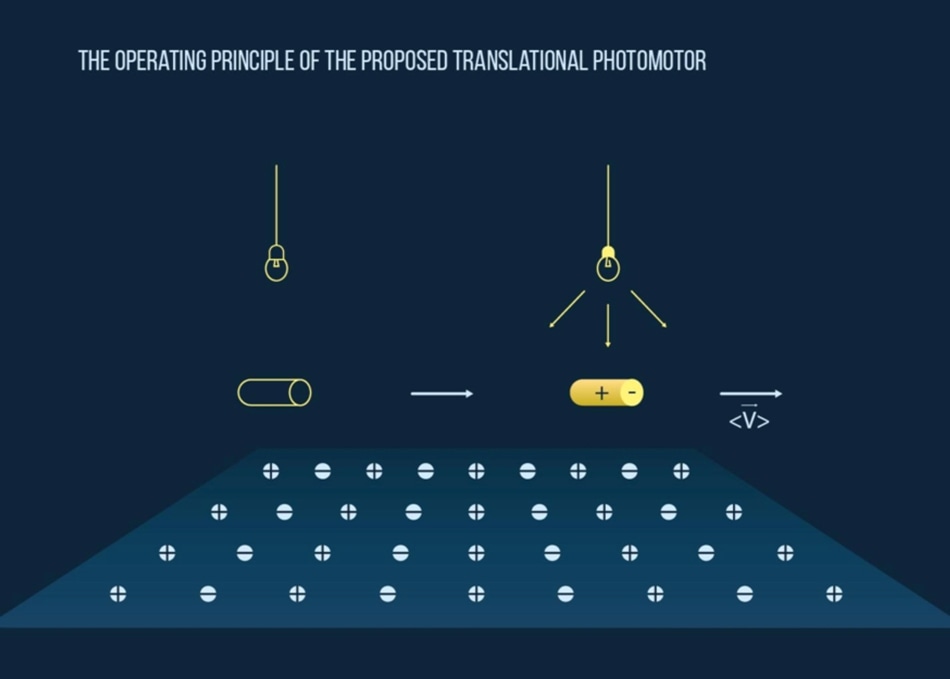Nov 11 2016
 The operating principle of the proposed translational photomotor. Credit: Image courtesy of MIPT press office.
The operating principle of the proposed translational photomotor. Credit: Image courtesy of MIPT press office.
A research team from the Semenov Institute of Chemical Physics of the Russian Academy of Sciences (ICP RAS), Moscow Institute of Physics and Technology (MIPT), and Chuiko Institute of Surface Chemistry of the National Academy of Sciences of Ukraine (ISC NASU) has presented a nanosized dipole photomotor model that works on the principle of light-induced charge redistribution.
This minute device has the potential of achieving directed motion at record speeds when triggered with a laser pulse, and has enough power to carry specific loads. The results of the study are reported in the Journal of Chemical Physics.
The unprecedented characteristics of dipole photomotors based on semiconductor nanoclusters offer the prospect of more than just addressing a certain scarcity of the translational photomotors family. These devices could actually be applied wherever rapid nanoparticle transport is required. In chemistry and physics, they could help develop new analytical and synthetic instruments, while in biology and medicine they could be used to deliver drugs to diseased tissues, improve gene therapy strategies, and so on.
Prof. Leonid Trakhtenberg of the Department of Molecular and Chemical Physics at MIPT
Trakhtenberg is the leader of the research team and the head of the Laboratory of Functional Nanocomposites at ICP RAS.
Prof. Trakhtenberg worked along with Prof. Viktor Rozenbaum, who is the head of the Department of Theory of Nanostructured Systems at ISC NASU, to develop the concept of photoinduced molecular transport for designing nanomachines whose movements can be controlled with a laser. The researchers have successfully demonstrated the relationship between the device’s key performance characteristic (i.e. its average velocity) and various model parameters such as particle dimensions, photoexcitation conditions, and so on.
Brownian motors
Prototypes of directed nanomotors exist by nature. Living organisms employ protein devices driven by exterior nonequilibrium processes having differing nature, called Brownian or molecular motors. They can convert random Brownian movement into directed reciprocation, translational motion, or rotation.
Brownian motors play a vital role in cell mobility such as flagellar motility in bacteria, muscle contraction, and intra- and intercellular transport of larger particles of numerous substances and organelles (e.g. “cell eating”, or phagocytosis, and metabolic waste product elimination from cells). These devices function with an incredibly higher efficiency that is close to 100%.
Understanding the underlying mechanisms of the operation of naturally occurring molecular motors enables us not only to replicate them but also to design new highly efficient multifunctional artificial devices that could eventually be applied in nanorobotics. For the last several decades, researchers and engineers in various fields have been working together and making some real progress towards the development of controllable nanomachines. The results of their work were recognized as a highly relevant achievement and a significant advance in science and technology, when the 2016 Nobel Prize in Chemistry was awarded ‘for the design and synthesis of molecular machines.'
Prof. Viktor Rozenbaum, ISC NASU
A Brownian motor functions by transitioning between at least two discrete states through light pulses, chemical reactions, AC signals, or thermal action. In the case of light pulses, the device is called a photomotor.
Around a decade ago, a model was created to demonstrate thes working of a translational dipole photomotor that functions when the molecule (particle) is photoexcited to a state in which its dipole moment varies from the ground state dipole moment. The efficiency and average velocity of the motor were shown to be higher when the difference between the sum of the dipole moments of the nanoparticle under both energy states was greater.
Laser triggering
A resonant laser pulse that excites electrons in the cylindrical semiconductor nanocluster was used to activate the proposed motor, which resulted charge separation and initiated an electrostatic interaction between the polar substrate and the particle.
Exciting the nanocylinder with periodic resonant laser pulses results in the variation of its potential energy in the substrate field along with time, consequently enabling directed motion.
Photomotors formed from inorganic nanoparticles are far more superior in terms of average velocity and efficiency when compared to those based on organic molecules. The dipole moment value in a cylinder-shaped semiconductor nanocluster prior to irradiation approximately equals zero.
However, an enormous dipole moment - i.e. close to 40 D in the case of a cylinder with a height of ca 15 Å—results when an electron is photoexcited from the bulk to the surface.
“Owing to the fact that the parameters of the device have been optimized, our proposed model photomotor based on a semiconductor nanocylinder moves at a record speed of 1 mm/s, which is approximately three orders of magnitude faster than similar models based on organic molecules or motor proteins in living organisms,” the authors of the study told us.